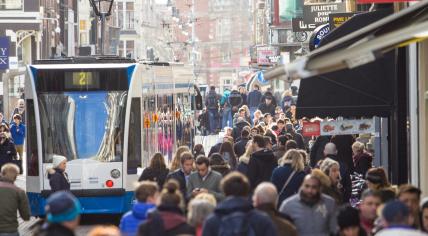
Current plans will make Amsterdam public transport less attractive: Rover, SME Assoc.
Travelers’ association Rover and the association for small- and medium-sized businesses in the Amsterdam region, MKB-Metropool Amsterdam, are against Vervoerregio Amsterdam’s plans to reduce public transport in the city center. Rover said it would make using public transport much less attractive. Guido Frankfurther of MKB-Metropool Amsterdam said: “I think it is a bad thing that many routes in the city will no longer be served and that the tram will run less often in old neighborhoods.”
In May last year, Vervoerregio Amsterdam released a document that included the plan to reduce the number of bus and tram lines in the city center. According to Vervoerregio Amsterdam, the old city center does not have the infrastructure topeoperly absorb the increasing pressure. “In combination with the desire to make the city more liveable, car-free, and therefore, greener, this has consequences for public transport. These consequences are: fewer bus and tram lines through the city center to the central station, but more high-quality public transport connections that connect the ‘inner ring’ around the old center,” it stated in the document Amsterdam 2025 concession grant.
In March last year, the GVB also said it might want to run fewer trams, buses, and metros due to declining passenger numbers and cost increases. The GVB said it struggled with inflation, higher equipment, wage, and energy costs, and staff shortages due to the tight labor market. The Amsterdam public transport company said it was forced to take a step back, which meant that travelers would have to transfer more often in the future.
Rover worries that this will make public transport in Amsterdam much less attractive. It is particularly concerned about the fact that Vervoerregio Amsterdam plans to stop running tram lines from outside the A10 to the center beyond the inner ring, and run fewer trams in the older neighborhoods. Some 16,000 travelers will have to endure extra transfers as a result.
“The focus is mainly on walking and cycling, but that is not a solution for everyone,” Marinus de Jong of Rover-Amsterdam said. “New housing estates outside the A10 are not reserves with a fence around them. These people will also have to get to the center close to where they want to be and then continue on foot.”
Guido Frankfurther of MKB-Metropool Amsterdam called reducing public transport a bad plan. “The need for public transport in these parts of the city will not decrease, and the biggest driver for the economy and employment in our metropolis does not deserve a deterioration in accessibility by public transport,” he said to AT5.
Frankfurter pointed out that the Amsterdam population is expected to continue growing, as will the number of passengers traveling through the Central Station. “With 20 percent more residents, it will become busier in the city, certainly also in the other centers in the city, but that does not mean that the absolute numbers of visitors to the center and the old neighborhoods will decrease.”
Amsterdam City Council members on the Mobility, Public Transport, and Water Committee will discuss the proposal for 2025 and the years ahead during their meeting on Thursday afternoon. The meeting agenda included Rover’s objections as a possible discussion topic.
A total of 36 of the 45 City Council members sit on the influential committee, which is chaired by Labour Party member Amel Namane.
The Amsterdam regional transport association, Vervoerregio Amsterdam, is made up of officials from 14 area municipalities to coordinate traffic and public transport policy. The organization’s first General Affairs Committee meeting of the year is scheduled for Tuesday evening, and the management board will also meet later this week.
If approved, the concession will be put out for tender with the decision determining which organizations will operate public transport services in the Amsterdam region for an 11-year term, and how they will work together and with the GVB, the city’s public transport firm. A draft letter from Amsterdam Alderman Melanie van der Horst, who handles traffic and public transport policy for the city, indicated that she is mainly positive about the Amsterdam Vervoerregio proposal. She praised its focus on more reliability rather than speed and efficiency.
“These requirements lay an important foundation for future mobility in our city and region,” she wrote in a draft letter post-dated for the end of this month. She said the capital’s ambitions are well-represented in the document, which will develop the public transport network in a way that contributes “to a healthier, more sustainable and more inclusive city.”
Van der Horst noted that local political leadership is “working on a car-free city with an important role for walking, cycling and public transport.” That factor, combined with the city’s expected growth of another 250,000 residents and 200,000 workers commuting to the city by 2050, should dictate future needs. “The combination of growth and mobility transition will lead to an expected growth in public transport use by around 40% in 2050.”
The alderman did have some criticism, saying the city cannot move forward with its ambitions without a greater focus on affordability for lower-income households and more overnight public transport service, noting the harsh cuts still in effect since the coronavirus pandemic. She also noted that the Vervoerregio assessment did not fully look at neighborhoods developing with more jobs despite few homes planned for the area, like areas in the eastern portion of Amsterdam-Noord. She also lobbied for more public input when changing the schedules of the Metro subway service.
“We want Amsterdam to be a city with clean air, green streets, and more places where city dwellers can meet each other and where children can play; a city that is prepared for climate change. We also need space to travel from A to B, where mobility is a means to participate and to keep the city economically strong.”
